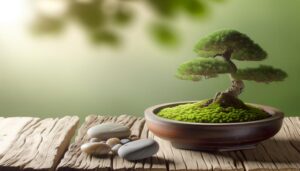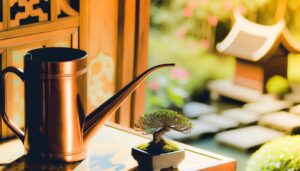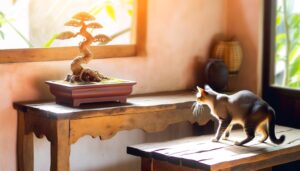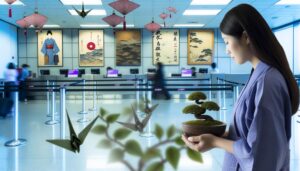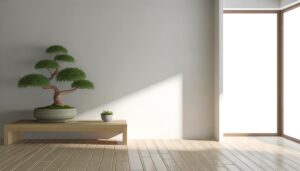What Are the Different Types of Bonsai Styles?
Bonsai styles represent a range of artistic expressions rooted in precise horticultural practices. Formal Upright features a perfectly vertical trunk exemplifying symmetry, while Informal Upright displays subtle bends reflecting naturalistic growth.
Slanting styles capture dynamic angles, and Windswept mimics trees shaped by constant wind. Cascade and Semi-Cascade styles depict trees growing on cliffs, with trunks extending outward and downward.
Unique forms such as Raft simulate forest scenes, Broom showcases fine branching in a spherical canopy, and Multi-Trunk displays interconnected growth from a single root base. Each style holds profound artistic and horticultural significance, inviting deeper exploration.
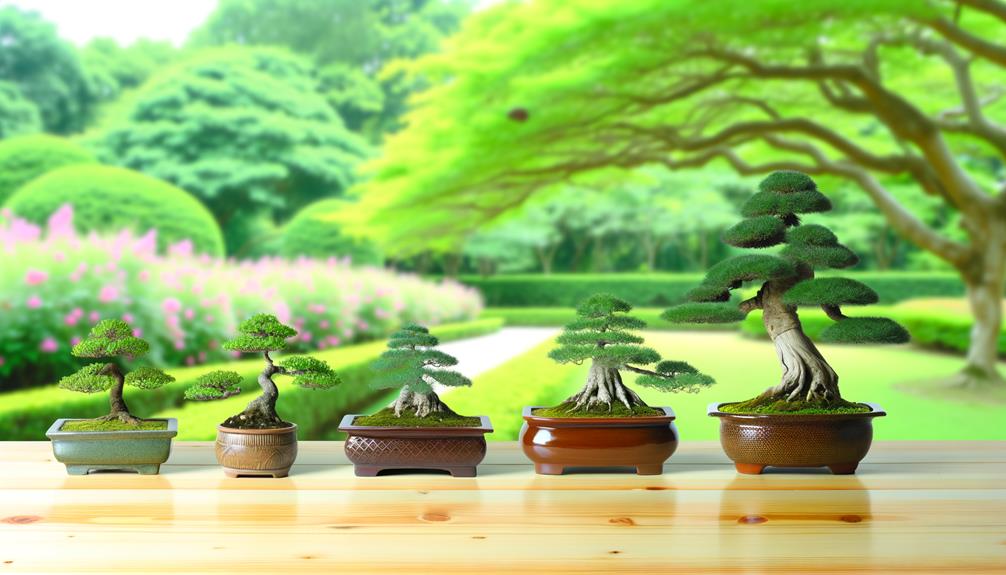
Key Takeaways
- Formal Upright features a perfectly vertical trunk and symmetrical branch arrangement.
- Informal Upright has a trunk with subtle bends and branches emerging from outer curves.
- Slanting style mimics trees shaped by winds, with trunks growing at an angle.
- Cascade style features a trunk extending below the container, mimicking cliffside growth.
- Raft Style showcases vertical growth from a prostrate trunk, resembling a forest.
Formal Upright
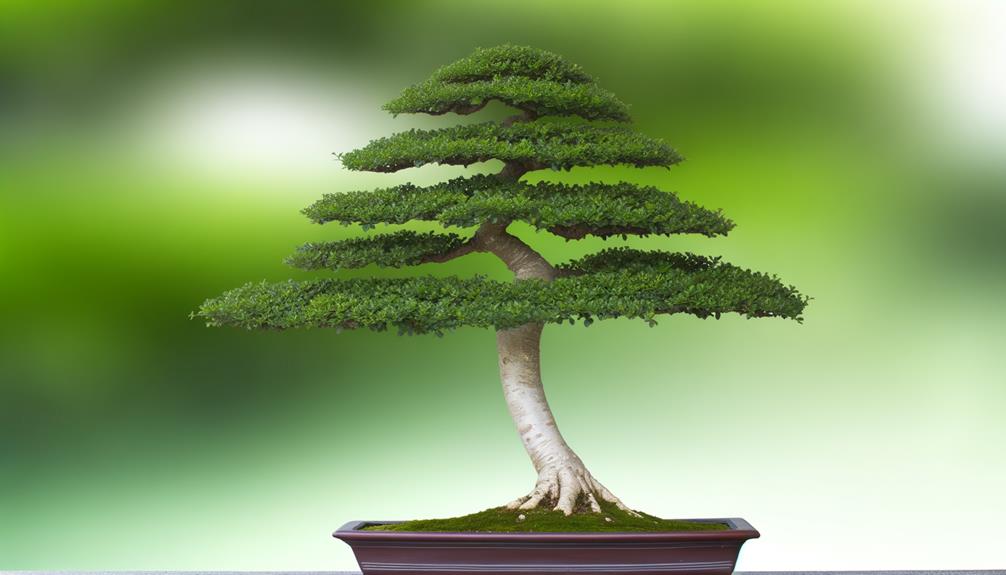
The Formal Upright style, or Chokkan, is characterized by a perfectly vertical trunk that exemplifies the idea of symmetry and balance in bonsai artistry.
This style mirrors a tree growing in prime conditions, free from external disturbances. The primary trunk ascends straight, tapering naturally to the apex, which should ideally be positioned directly above the base.
Branches are arranged in a systematic, descending order, with the largest at the bottom, progressively decreasing in size as they rise. Each branch is meticulously pruned to maintain a triangular shape, enhancing the tree's overall harmony.
The roots, or nebari, should radiate uniformly from the trunk base, anchoring the tree firmly and symbolizing strength and stability. This style demands rigorous attention to detail and precision.
Informal Upright
While the Formal Upright style embodies symmetry and order, the Informal Upright style, or Moyogi, introduces a gentle, naturalistic curvature to the trunk, reflecting trees shaped by varying environmental factors. This style captures the essence of trees in nature that adapt to their surroundings, demonstrating resilience and organic growth patterns.
Key characteristics include:
- Trunk Curvature: The trunk of the Moyogi style displays subtle, elegant bends, creating a visually dynamic flow.
- Branch Placement: Branches emerge from the outer curves of the bends, enhancing the tree's naturalistic appearance.
- Tapering: The trunk should gradually taper from base to apex, ensuring a proportionate and balanced structure.
These elements collectively form a harmonious and aesthetically pleasing representation of natural tree growth.
Slanting
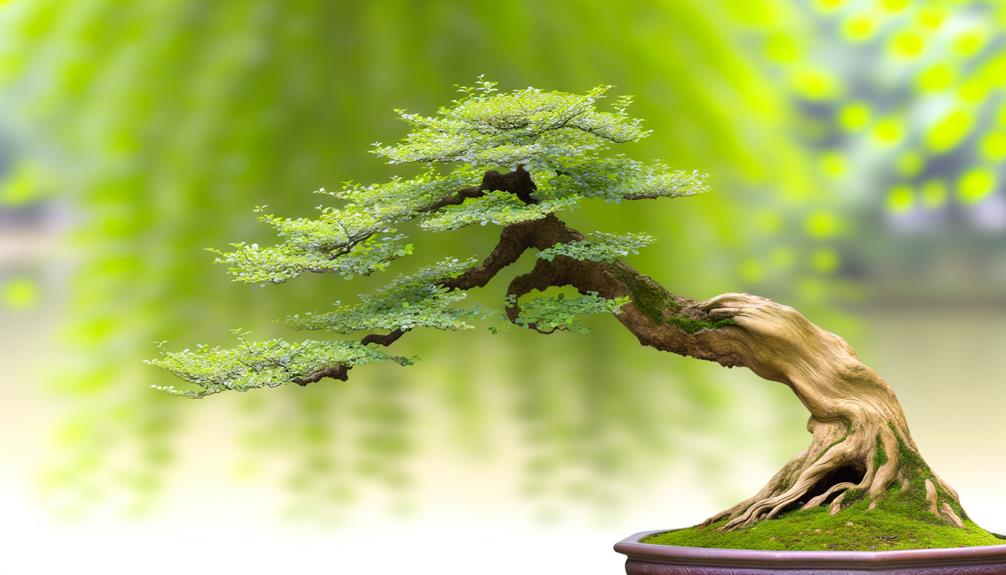
Slanting bonsai, or Shakan, features a trunk that grows at an angle relative to the soil, mimicking trees shaped by persistent winds or unstable ground conditions. The trunk may lean dramatically, but it maintains balance and grace. Root structure plays a critical role, with roots anchoring on the side opposite the lean to stabilize the tree.
Branches are arranged asymmetrically to enhance the dynamic visual effect, often with lower branches extending horizontally or slightly downward. This style underscores the resilience and adaptability of nature. The apex typically points upwards, counteracting the slant to convey a sense of equilibrium.
Shakan bonsai requires careful pruning and wiring to achieve the desired aesthetic, ensuring the tree's health and structural integrity.
Cascade
Cascade bonsai, or Kengai, replicates the natural phenomenon of trees growing on cliffsides or steep slopes, with branches and trunk cascading downward in a graceful, flowing manner. This style captures the essence of resilience and adaptation seen in nature.
To achieve this aesthetic, the following key elements are essential:
- Primary Trunk Angle: The trunk must extend below the base of the container, mimicking gravity's pull.
- Branch Placement: Lower branches should be shorter and upward-facing to balance the visual weight, while upper branches extend downward.
- Container Selection: Typically, deep pots are used to accommodate the trunk's downward movement, ensuring stability.
Artistic insight and technical precision are paramount in crafting a Kengai bonsai that truly embodies this unique and dramatic style.
Semi-Cascade
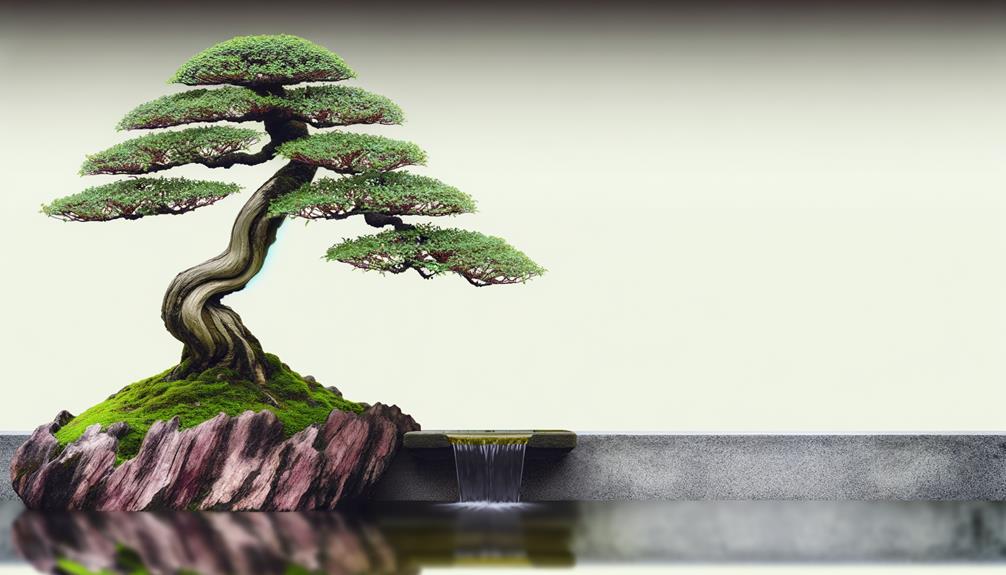
Semi-Cascade bonsai, or Han-Kengai, embodies a harmonious balance between the upright and cascading forms, where the trunk extends outward and downward but does not descend below the base of the container. This style reflects natural growth on cliffs or riverbanks, with branches angling gracefully downward. Key elements include a strong, well-tapered trunk and a prominent primary branch. The foliage pads should be meticulously spaced to create depth and perspective.
| Aspect | Description |
|---|---|
| Trunk Movement | Outward and downward, above container base |
| Natural Inspiration | Cliff and riverbank growth |
| Key Components | Tapered trunk, prominent primary branch |
The Semi-Cascade style offers a blend of dynamic movement and structural stability, making it a visually compelling and technically challenging bonsai form.
Literati
In stark contrast to the structured elegance of Semi-Cascade, the Literati style, or Bunjin-gi, epitomizes minimalist beauty and expressive form, characterized by its slender, often contorted trunk and sparse foliage that evoke the poetic essence of trees surviving in harsh environments. This bonsai style emphasizes artistic expression over strict adherence to naturalistic form, embodying the essence of wabi-sabi, or beauty in imperfection.
Key features of Literati bonsai include:
- Trunk shape: A graceful, often exaggeratedly curved trunk that suggests resilience.
- Sparse foliage: Minimal leaf coverage, highlighting the trunk's form and movement.
- Aesthetic balance: Careful positioning within the pot to enhance artistic asymmetry.
The Literati style demands a deep understanding of both horticulture and artistic principles.
Forest
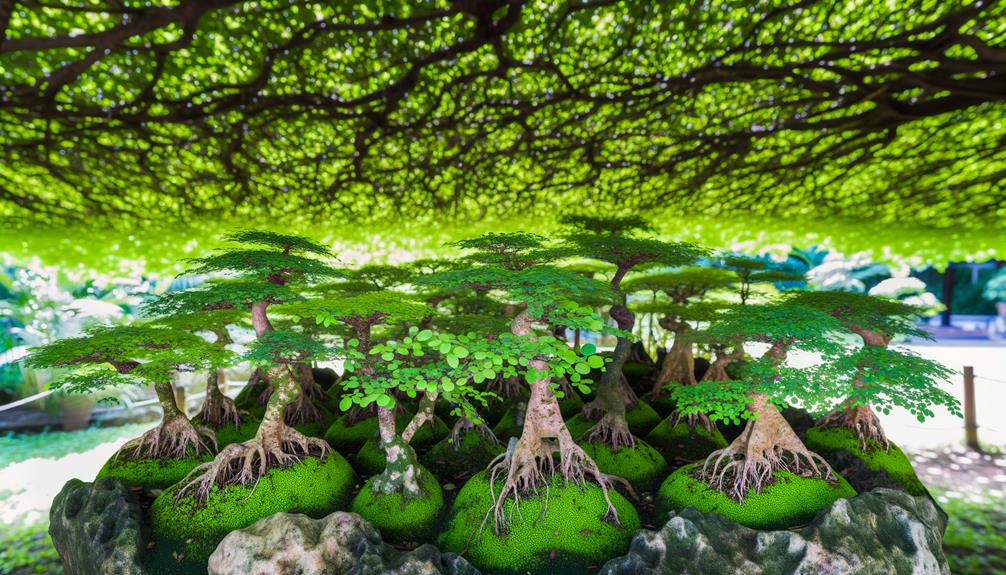
The Forest style, or Yose-ue, captures the majestic essence of natural woodlands by artfully arranging multiple trees within a single container, thereby creating a miniature, yet profoundly evocative, landscape.
This style often employs odd numbers of trees, strategically placed to mimic the asymmetry found in nature. Varied trunk thicknesses and heights are essential to achieve depth and perspective, enhancing the illusion of a sprawling forest.
The careful selection of complementary species guarantees visual harmony and ecological balance. Moss, rocks, and other ground cover elements are used to simulate the forest floor, contributing to the authenticity of the scene.
Mastery of Yose-ue requires an understanding of spatial dynamics and an artistic eye to evoke the serene beauty of a natural forest.
Raft
The Raft style, or Ikadabuki, exemplifies a natural forest imitation where multiple trunks emerge from a single, horizontally lain trunk, mimicking a fallen tree that continues to grow.
This unique design requires meticulous attention to the horizontal trunk's placement and the development of evenly distributed branches to create a harmonious and realistic forest scene.
The artistic challenge lies in ensuring that each 'trunk' exhibits sufficient variation in height and thickness to enhance the overall aesthetic complexity and natural appearance.
Natural Forest Imitation
How does one capture the essence of a natural forest within the confines of a single bonsai pot? The answer lies in the 'Raft' style of bonsai, wherein a single tree trunk lays horizontally, mimicking a forest floor.
This style involves the following key techniques:
- Trunk Placement: Position the trunk horizontally, ensuring that roots grow from the underside while branches ascend, creating the illusion of multiple trees.
- Root Development: Promote root growth along the buried trunk to guarantee stability and nutrient uptake, crucial for the miniature forest's health.
- Branch Pruning: Regularly trim and shape branches to foster a naturalistic, forest-like appearance, paying close attention to varying branch heights and thicknesses to enhance realism.
Embrace these principles to cultivate a stunning bonsai forest.
Horizontal Trunk Design
In bonsai artistry, the Horizontal Trunk Design or 'Raft' style emphasizes laying a tree trunk horizontally to simulate a forest floor, allowing branches to ascend and form a cohesive and dynamic miniature forest. This technique, known as Ikadabuki in Japanese, capitalizes on a tree's natural ability to produce new vertical growth from a prostrate trunk.
The primary trunk acts as a root system, anchoring the structure and enhancing stability. Branches develop upwards, mimicking individual trees in a forest. Proper wiring and pruning are essential to guarantee balanced growth and aesthetic harmony.
The Raft style is ideal for showcasing the intricate interplay between unity and diversity, encapsulating the essence of a natural woodland within the confines of a bonsai pot.
Broom
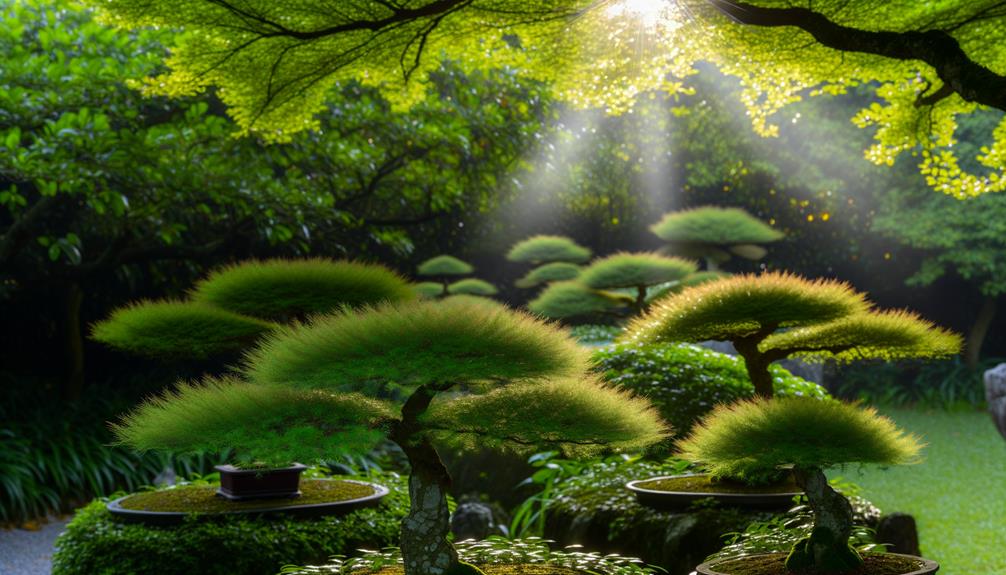
Characterized by its symmetrical, upright form and densely branched canopy, the Broom style (Hokidachi) embodies a meticulously balanced and visually appealing bonsai aesthetic. This style features a straight trunk, typically devoid of significant curves, culminating in an explosion of fine branches that fan out to create a rounded, umbrella-like crown.
The Broom style is particularly suited for deciduous trees with fine branching, such as the Zelkova.
Key characteristics of the Broom style include:
- Trunk and Branching: A straight, vertical trunk with evenly distributed branches.
- Canopy Shape: A spherical or dome-like canopy, formed by intricate, radiating branches.
- Seasonal Appeal: This style showcases a striking silhouette in winter, highlighting the delicate branch structure.
Multi-Trunk
Embracing complexity and natural forest aesthetics, the Multi-Trunk style (Kabudachi) features multiple trunks emerging from a single root base, creating a miniature grove within a single bonsai. This style captures the essence of interconnectedness and symbiosis found in nature.
The primary trunk, often the thickest and tallest, is complemented by secondary trunks, each varying in height and girth to evoke a sense of depth and maturity. Proper pruning and wiring techniques are essential to maintain balance and prevent tangling.
The Kabudachi style requires meticulous root management to guarantee even nutrient distribution. This style not only showcases technical proficiency but also reflects an artistic vision of unity and diversity, making it a revered choice among bonsai enthusiasts.
Windswept
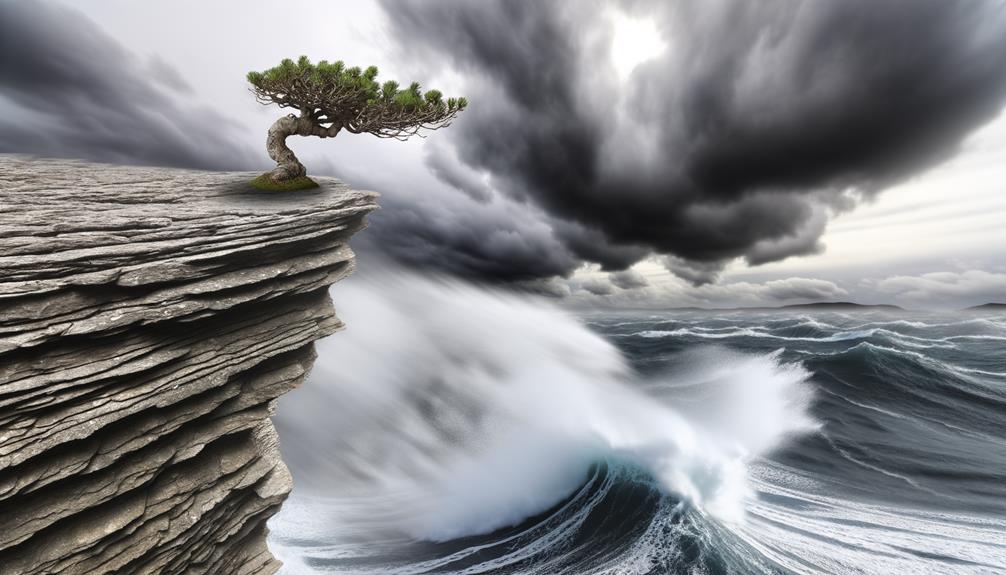
The Windswept style (Fukinagashi) captures the raw and dynamic energy of trees battered by relentless winds, with branches and foliage uniformly swept in one direction, evoking a powerful sense of movement and resilience. This style requires meticulous attention to branch placement, ensuring each element aligns cohesively to create a natural wind-torn appearance.
Key considerations include:
- Branch Structure: Branches should extend horizontally or slightly downward, reflecting the persistent force of wind.
- Trunk Positioning: The trunk may lean to one side, but it must appear sturdy and enduring despite the directional pull.
- Foliage Distribution: Balance is essential; foliage should be denser on the leeward side to realistically simulate wind impact.
Mastering Fukinagashi demands both technical skill and artistic sensibility.
Conclusion
To sum up, the diverse array of bonsai styles presents distinctive aesthetic and technical challenges. These styles include Formal Upright, Informal Upright, Slanting, Cascade, Semi-Cascade, Raft, Broom, Multi-Trunk, and Windswept.
Remarkably, the art of bonsai can be traced back over a thousand years, originating in China and further developed in Japan. This historical longevity emphasizes its lasting allure and intricacy, encouraging both beginners and seasoned enthusiasts to delve into its detailed beauty and horticultural precision.

